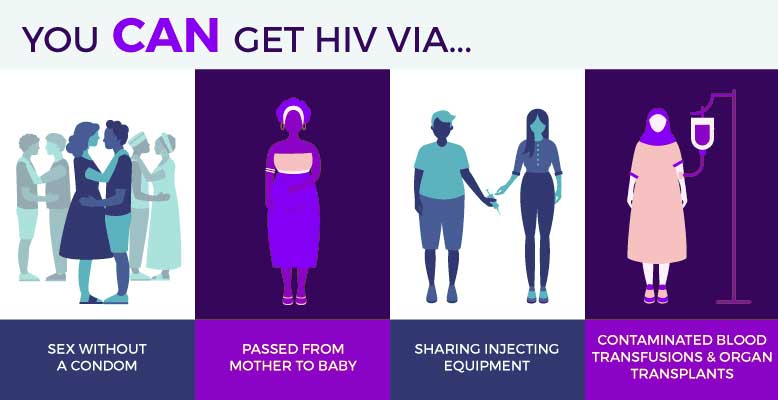AIDS, or acquired immune deficiency syndrome, was first reported in the United States in 1981 and has since become a major worldwide epidemic. AIDS is caused by the human immunodeficiency virus. By killing or impairing cells of the immune system, HIV progressively destroys the body’s ability to fight infections and certain cancers. Individuals diagnosed with AIDS are susceptible to life-threatening diseases called opportunistic infections, which are caused by microbes that usually do not cause illness in healthy people.

More than 600,000 cases of AIDS have been reported in the United States since 1981, and as many as 900,000 Americans may be infected with HIV. The epidemic is growing most rapidly among minority populations and is a leading killer of African-American males. According to the U.S. Centers for Disease Control and Prevention, the prevalence of AIDS is six times higher in African-Americans and three times higher among Hispanics than among whites.
Transmission
HIV is spread most commonly by sexual contact with an infected partner. The virus can enter the body through the lining of the vagina, vulva, penis, rectum or mouth during sex.
HIV also is spread through contact with infected blood. Prior to the screening of blood for evidence of HIV infection and before the introduction in 1985 of heat-treating techniques to destroy HIV in blood products, HIV was transmitted through transfusions of contaminated blood or blood components. Today, because of blood screening and heat treatment, the risk of acquiring HIV from such transfusions is extremely small.
HIV frequently is spread among injection drug users by the sharing of needles or syringes contaminated with minute quantities of blood of someone infected with the virus. However, transmission from patient to health-care worker or vice-versa via accidental sticks with contaminated needles or other medical instruments is rare.
Women can transmit HIV to their fetuses during pregnancy or birth. Approximately one-quarter to one-third of all untreated pregnant women infected with HIV will pass the infection to their babies. HIV also can be spread to babies through the breast milk of mothers infected with the virus. If the drug AZT is taken during pregnancy, the chance of transmitting HIV to the baby is reduced significantly. If AZT treatment of mothers is combined with cesarean sectioning to deliver infants, infection rates can be reduced to 1 percent.
Although researchers have detected HIV in the saliva of infected individuals, no evidence exists that the virus is spread by contact with saliva. Laboratory studies reveal that saliva has natural compounds that inhibit the infectiousness of HIV. Studies of people infected with HIV have found no evidence that the virus is spread to others through saliva such as by kissing. No one knows, however, the risk of infection from so-called ‘deep’ kissing, involving the exchange of large amounts of saliva, or by oral intercourse. Scientists also have found no evidence that HIV is spread through sweat, tears, urine or feces.
Studies of families of HIV-infected people have shown clearly that HIV is not spread through casual contact such as the sharing of food utensils, towels and bedding, swimming pools, telephones or toilet seats. HIV is not spread by biting insects such as mosquitoes or bedbugs.
HIV can infect anyone who practices risky behaviors such as:
- Sharing drug needles or syringes
- Having sexual contact without using a latex male condom with an infected person or with someone whose HIV status is unknown.
- Having another sexually transmitted disease such as syphilis, herpes, chlamydial infection, gonorrhea or bacterial vaginosis appears to make someone more susceptible to acquiring HIV infection during sex with an infected partner.

Early symptoms
Many people do not develop any symptoms when they first become infected with HIV. Some people, however, have a flu-like illness within a month or two after exposure to the virus. They may have fever, headache, malaise and enlarged lymph nodes (organs of the immune system easily felt in the neck and groin). These symptoms usually disappear within a week to a month and are often mistaken for those of another viral infection. People are very infectious during this period, and HIV is present in large quantities in genital secretions.
More persistent or severe symptoms may not surface for a decade or more after HIV first enters the body in adults, or within two years in children born with HIV infection. This period of ‘asymptomatic’ infection is highly variable. Some people may begin to have symptoms in as soon as a few months, whereas others may be symptom-free for more than 10 years. During the asymptomatic period, however, HIV is actively multiplying, infecting and killing cells of the immune system. HIV’s effect is seen most obviously in a decline in the blood levels of CD4+ T cells (also called T4 cells), the immune system’s key infection fighters. The virus initially disables or destroys these cells without causing symptoms.
As the immune system deteriorates, a variety of complications begins to surface. One of the first such symptoms experienced by many people infected with HIV is large lymph nodes or ‘swollen glands’ that may be enlarged for more than three months. Other symptoms often experienced months to years before the onset of AIDS include a lack of energy, weight loss, frequent fevers and sweats, persistent or frequent yeast infections (oral or vaginal), persistent skin rashes or flaky skin, pelvic inflammatory disease that does not respond to treatment, or short-term memory loss.
Some people develop frequent and severe herpes infections that cause mouth, genital or anal sores, or a painful nerve disease known as shingles. Children may have delayed development or failure to thrive.
AIDS
The term AIDS applies to the most advanced stages of HIV infection. Official criteria for the definition of AIDS are developed by the CDC in Atlanta, Ga., which is responsible for tracking the spread of AIDS in the United States.
In 1993, the CDC revised its definition of AIDS to include all HIV-infected people who have fewer than 200 CD4+ T cells. (Healthy adults usually have CD4+ T-cell counts of 1,000 or more.) In addition, the definition includes 26 clinical conditions that affect people with advanced HIV disease. Most AIDS-defining conditions are opportunistic infections, which rarely cause harm in healthy individuals. In people with AIDS, however, these infections are often severe and sometimes fatal because the immune system is so ravaged by HIV that the body cannot fight off certain bacteria, viruses and other microbes.



